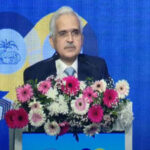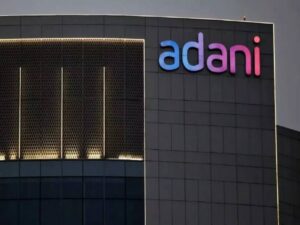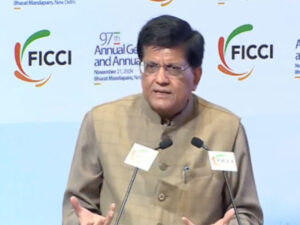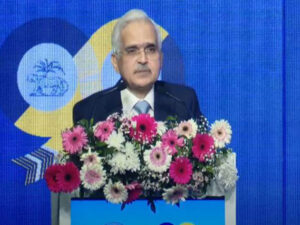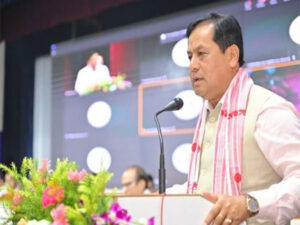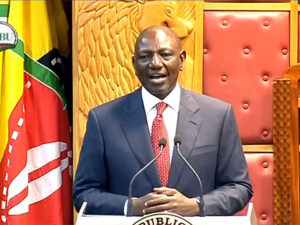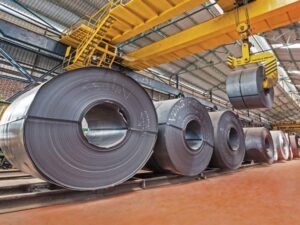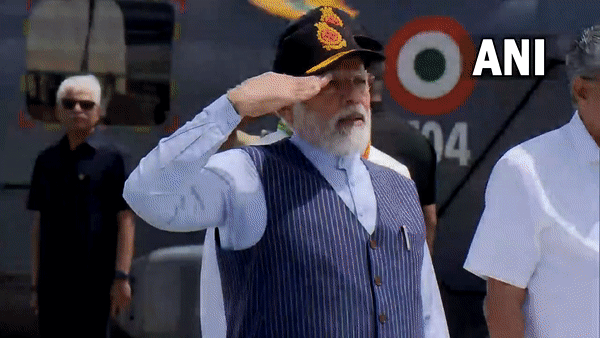
By Rajnish Singh
Kochi (Kerala) [India], September 2 (ANI): Prime Minister Narendra Modi on Friday unveiled the new Naval Ensign ‘Nishaan’ at Cochin Shipyard Limited here in Kochi, doing away with the colonial past and befitting the rich Indian maritime heritage. The Prime Minister unveiled the new Naval Ensign ‘Nishaan’ during the commissioning of the indigenous aircraft carrier INS Vikrant.
Naval Ensigns are flags that naval ships or formations bear to denote nationality. The current Indian Naval Ensign consists of a St. George’s Cross — a red cross with white background.
In one corner of the cross, the Indian flag was put when the country attained freedom, replacing the Union Jack in that place.
The Indian Naval Ensign has changed multiple times since Independence. It was only in 2001 that the St George’s Cross was taken out and the Indian Navy’s crest was added to the opposite corner of the ensign. The cross was put back again in 2004 with the addition of the emblem of India at the intersection of the cross.
Designed by the Indian Navy’s in-house Warship Design Bureau (WDB) and built by Cochin Shipyard Limited, a Public Sector Shipyard under the Ministry of Ports, Shipping and Waterways, Vikrant has been built with state-of-the-art automation features and is the largest ship ever built in the maritime history of India.
The Indigenous Aircraft Carrier is named after her illustrious predecessor, India’s first aircraft carrier, which had played a vital role in the 1971 war.
It has a large amount of indigenous equipment and machinery, involving major industrial houses in the country as well as over 100 MSMEs. With the commissioning of Vikrant, India will have two operational aircraft carriers, which will bolster the maritime security of the nation.
As per the Indian Navy, the 262-meter-long carrier has a full displacement of close to 45,000 tonnes which is much larger and more advanced than her predecessor.
With Vikrant, India has joined a select group of nations having the niche capability to indigenously design and build an aircraft carrier.IAC Vikrant consist of 14 decks with 2,300 compartments which can carry around 1,500 sea warriors and to cater to the food requirements, around 10,000 chapatis or rotis are made in the ship’s kitchen, which is called the ship’s galley.
The ship is powered by four Gas Turbines totalling 88 MW power and has a maximum speed of 28 Knots. Built at an overall cost of close to Rs 20,000 crores, the project has been progressed in three Phases of the contract between MoD and CSL, concluded in May 2007, December 2014 and October 2019 respectively.
The ship’s keel was laid in February 2009, followed by launching in August 2013. With an overall indigenous content of 76 per cent, IAC is a perfect example of the nation’s quest for “Aatma Nirbhar Bharat” and provides a thrust to Government’s ‘Make in India’ initiative. (ANI)
INS Vikrant testament to hard work, influence and commitment of 21st century India: PM Modi
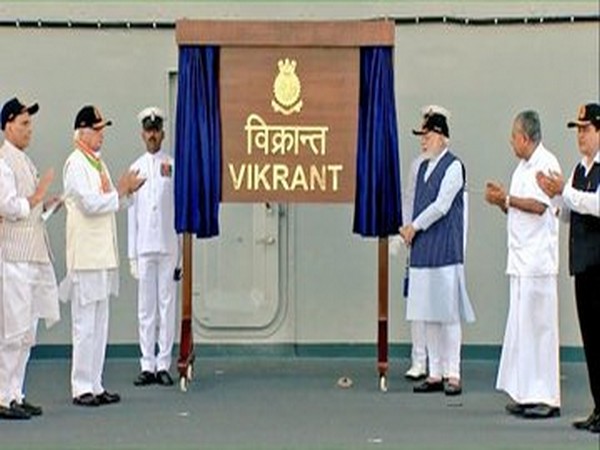
Kochi (Kerala) [India], September 2 (ANI): Showcasing the country’s growing prowess of indigenous manufacturing, Prime Minister Narendra Modi commissioned the country’s first indigenous aircraft carrier INS Vikrant on Friday and said it is not just a warship but a testament to the hard work, talent, influence and commitment of 21st century India. During the event, the Prime Minister also unveiled the new Naval Ensign (Nishaan), doing away with the colonial past and befitting the rich Indian maritime heritage. He dedicated the new ensign to Chhatrapati Shivaji.
Addressing the gathering, the Prime Minister said, here on the coast of Kerala, every Indian is witnessing the sunrise of a new future. “This event being held on the INS Vikrant is a tribute to the rising spirits of India on the world horizon. Today we are seeing a manifestation of the dream of the freedom fighters where they envisioned a capable and strong India,” he said.
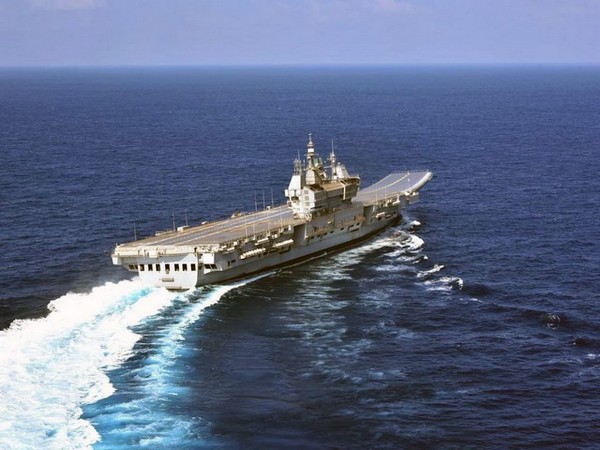
The Prime Minister exclaimed “Vikrant is huge, massive, and vast. Vikrant is distinguished, and Vikrant is also special. Vikrant is not just a warship. This is a testament to the hard work, talent, influence and commitment of India in the 21st century. If the goals are distant, the journeys are long, the ocean and the challenges are endless – then India’s answer is Vikrant. The incomparable Amrit of Azadi ka Amrit Mahotsav is Vikrant. Vikrant is a unique reflection of India becoming self-reliant.”
Commenting on the new mood of the nation, the Prime Minister said, no challenge is too difficult for today’s India. “Today, India has joined those countries in the world, which manufacture such a huge aircraft carrier with indigenous technology. Today INS Vikrant has filled the country with new confidence, and has created a new confidence in the country,” said PM Modi.
The Prime Minister acknowledged and praised the contribution of the Navy, engineers of Cochin Shipyard, scientists and specially the workers who worked on the project. He also noted the happy and auspicious occasion of Onam that is adding even more happiness to the occasion. “Every part of INS Vikrant has its own merits, a strength, a development journey of its own. It is a symbol of indigenous potential, indigenous resources and indigenous skills. The steel installed in its airbase is also indigenous, developed by DRDO scientists and produced by Indian companies,” he said.
Explaining the massive proportions of the Carrier, the Prime Minister said it is like a floating city.
“It produces electricity that is sufficient to power 5000 households and the wiring used will reach Kashi from Kochi, he said. He said that INS Vikrant is a living embodiment of the Spirit of the Panch Prans that he proclaimed from the ramparts of Red Fort,” said the Prime Minister.
The Prime Minister talked about the Indian Maritime tradition and naval capabilities. “Chhatrapati Veer Shivaji Maharaj built such a navy on the strength of this sea power, which kept the enemies on their toes. When the British came to India, they used to be intimidated by the power of Indian ships and trade through them. So they decided to break the back of India’s maritime power. History is witness to how strict restrictions were imposed on Indian ships and merchants by enacting a law in the British Parliament at that time,” the Prime Minister said.
The Prime Minister noted that today on the historic date of September 2, 2022, India has taken off a trace of slavery, a burden of slavery. “The Indian Navy has got a new flag from today. Till now the identity of slavery remained on the flag of the Indian Navy. But from today onwards, inspired by Chhatrapati Shivaji, the new Navy flag will fly in the sea and in the sky,” he said.
The Prime Minister remarked that when Vikrant descends to protect our maritime zone, many women soldiers of the Navy will also be stationed there. “With the immense power of the ocean, boundless female power, it is becoming the lofty identity of the new India. Now the Indian Navy has decided to open all its branches for women. The restrictions that were there are now being removed. Just as there are no boundaries for the capable waves, there will be no boundaries or restrictions for the daughters of India,” he added.
The Prime Minister said drop by drop water becomes like a vast ocean. He also mentioned the salute by indigenous canon on this Independence Day while adding that similarly, if every citizen of India starts living the mantra of ‘Vocal for Local’, then it will not take long for the country to become self-reliant.
Commenting on the changing geo-strategic situation, he said in the past, security concerns in the Indo-Pacific region and the Indian Ocean have long been ignored. “But, today this area is a major defence priority of the country for us. That is why we are working in every direction, from increasing the budget for the Navy to increasing its capability,” he said.
The Prime Minister further said that a strong India will pave the way for a peaceful and safe world.
With the commissioning, India has entered into a select band of Nations having niche capability to indigenously design and build an Aircraft Carrier and real testimony to the Nation’s resolve for self-reliance and ‘Make in India’. INS Vikrant is designed by the Indian Navy’s in-house Warship Design Bureau (WDB) and built by Cochin Shipyard Limited, a Public Sector Shipyard under the Ministry of Ports, Shipping & Waterways, Vikrant has been built with state-of-the-art automation features and is the largest ship ever built in the maritime history of India.
The 262.5 m long and 61.6 m wide Vikrant displaces approx 43,000 T, having a maximum designed speed of 28 Knots with the endurance of 7,500 Nautical Miles. The ship has around 2,200 compartments, designed for a crew of around 1,600 including women officers and sailors. The carrier is designed with a very high degree of automation for machinery operations, ship navigation and survivability. The carrier is equipped with the latest state-of-the-art equipment and systems.
The ship is capable of operating an air wing consisting of 30 aircraft comprising of MiG-29K fighter jets, Kamov-31, MH-60R multi-role helicopters, in addition to indigenously manufactured Advanced Light Helicopters (ALH) and Light Combat Aircraft (LCA) (Navy). Using a novel aircraft-operation mode known as Short Take-Off But Arrested Recovery (STOBAR), INS Vikrant is equipped with a ski-jump for launching aircraft, and a set of ‘arrester wires’ for their recovery onboard.
With 76 per cent indigenous content, the construction of INS Vikrant has resulted in direct employment generation for over 2,000 employees of CSL. In addition, it has resulted in indirect employment generation for approx 12,500 employees for over 550 OEMs, sub-contractors, ancillary industries and over 100 MSMEs as well, thereby bolstering plough back effect on the economy.
Resonant to the ongoing national endeavour to move away from the colonial past, a need was felt to transition to a new design that drew inspiration from our history. The White Ensign identified nationwide with the Navy, now comprises of two main constituents – the National Flag in the upper left canton, and a Navy Blue – Gold octagon at the centre of the fly side (away from the staff).
The Octagon is with twin golden octagonal borders encompassing the golden National Emblem (Lion Capital of Ashoka – undescribed with ‘Satyamev Jayate’ in blue Devnagri script) resting atop an anchor; and superimposed on a shield. Below the shield, within the octagon, in a golden bordered ribbon, on a Navy Blue background, is inscribed the motto of the Indian Navy ‘Sam No Varunah’ in golden Devnagriscript.
The design encompassed within the octagon has been taken from the Indian Naval crest, wherein the fouled anchor, which is also associated with a colonial legacy, has been replaced with a clear anchor underscoring the steadfastness of the Indian Navy. (ANI)




